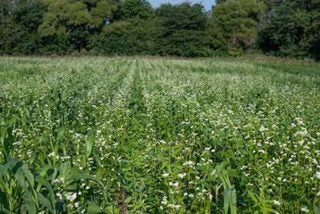- Resources
- Cover crop financial data from large database will inform climate-smart investments
Resources
Cover crop financial data from large database will inform climate-smart investments
Published: April 20, 2022 by Vincent Gauthier
Many farmers are interested in cover crops to build soil health but are wary of increased costs. Farmers can benefit by learning from their peers who have already adopted cover crops, particularly when high-quality economic information is collected in partnership with land-grant universities.
To scale financial analysis of climate-smart agriculture practices and help farmers profitably adopt cover crops, EDF collaborated with University of Minnesota’s Center for Farm Financial Management (CFFM) to integrate a new data gathering process into FINBIN — the largest publicly-available farm financial database in the country. EDF is also working with Minnesota State’s Farm Business Management (FBM) to gather data from farmers who grow cover crops and are participating in the program.
A recent report from FBM on the financial performance of environmental practices presents preliminary data on cover crop financial performance from 17 Minnesota farms growing cover crops. Over the coming years, the dataset will grow to over 85 farms that will be analyzed for financial performance trends.
Here are three financial questions the data will help answer over the coming years:
1. What expenses are incurred by growing cover crops?
Farmers need to manage the cost of every part of their operations. Cover crops are an additional expense to the typical grain operation in Minnesota. Documenting the additional expenses linked to growing cover crops can help farmers and their advisers manage costs.
As documented in the preliminary data, the cover crop financial benchmarking dataset will show costs for cover crop seeds, chemicals, fuel and oil, repairs and labor. In 2021, the 11 soybean farms that submitted cover crop financial data paid an average of $20 per acre for cover crop seed. Their average total direct expenses for the cover crop including seeds, fuel and oil, repair and labor costs were $55 per acre.
2. Do farmers growing cover crops achieve cost savings?
Farm financial case studies of climate-smart case studies conducted by EDF in recent years have shown that some farmers found cost savings that offset the additional expenses associated with using cover crops. These farmers were able to cut back on fertilizer expenses and equipment costs, often by integrating cover crops to a conservation tillage system.
By tying the cover crop budget to the following cash crop’s budget, the new cover crop financial benchmarking dataset will be able to look at cost differences in the cash crop between cover crop adopters and non-adopters. For example, the six corn farms that submitted cover crop financial data had lower fertilizer and crop chemical costs, but higher machinery and equipment repair costs as compared to the average farm not growing cover crops.
3. Is there a return on investment over time?
Soil health improvements take time to manifest after implementing climate-smart practices because building up organic matter can take multiple years of reduced tillage and cover cropping. Can the same be said of the financial benefits from these practices?
Analysis of a small sample of cover crop users by EDF, the Soil Health Partnership and agricultural accounting firm KCoe Isom showed that farmers with greater than five years of experience with cover crops had lower costs than farmers with less than five years of experience with cover crops.
EDF, CFFM and FBM are working on ways to evaluate changes in cost and yield over time associated with farmers experience with managing cover crops.
In the coming years, the newly developed cover crop financial benchmarking dataset will help answer financial questions farmers have about cover crops. Answering their questions with detailed farm financial data will also inform financial solutions to help producers adopt cover crops profitably.
Our Experts


